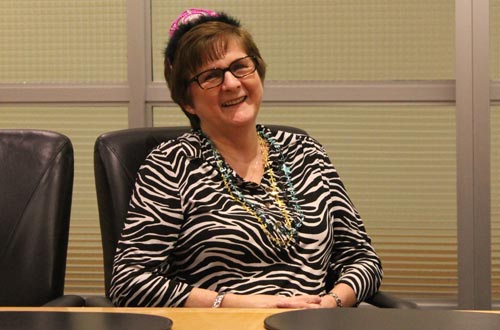
The Corporate Offices at the R. Fraser Elliott building held a retirement party for both Ruth and her colleague, Peggy Wood. After calling RFE home for 15 years, Ruth’s co-workers insisted that a crown and jewels were necessary accessories! (Photo: UHN)
On a chilly January day in 1970, 17-year-old Ruth Gopaul walked through the doors of Princess Margaret Hospital on Sherbourne St. She was looking for her first job.
She never dreamed it would be the only organization where she would ever want to work.
Now, 46 years later, Ruth is retiring. She's gone from filing hand-written clinic notes from doctors in the Medical Accounts Department to being the right-hand to five consecutive CEOs. Along the way, she's become woven into the fabric of UHN as an invaluable resource, a beloved co-worker, and a trusted confidante. That fresh-faced 17-year-old now has two sons, a granddaughter, aged 17, and two grandsons, aged 12 and 9.
While her locations and duties have changed over the years, Ruth's calmness and sense of humour have remained constant.
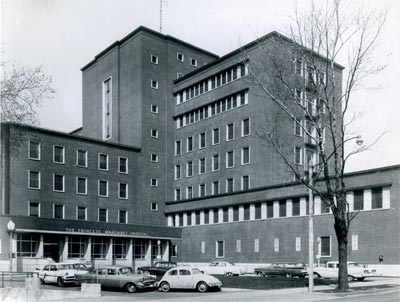
Ruth’s first job was the Princess Margaret Hospital at 500 Sherbourne St. (Image courtesy of University Health Network Archives, Toronto.)
"In midst of high workload and occasional frantic days, Ruth kept everyone on an even keel," remembers Dr. Alan Hudson, former President and CEO of UHN, who worked with Ruth. "On the most hectic days, it was always a comfort to me to know there was at least one sane person on the team.
"It's very easy to take an unassuming person for granted - I never did. I knew how important Ruth was to me, and to the hospital."
And as Ruth has grown, so has the "little hospital" on Sherbourne St. It's now a top five cancer centre and a major arm of UHN, Canada's biggest research hospital.
"Working here has been the only full-time job I've had," Ruth says of an organization that now encompasses four hospitals on eight sites. "And I've never wanted to leave."
Humble beginnings
Ruth recalls her first encounter with the Princess Margaret Hospital (PMH).
"I told them, 'I'll take whatever job you have,'" she laughs. Within a few days she had secured a position collecting hand-written clinic notes from physicians for filing. She was officially a junior clerk typist.
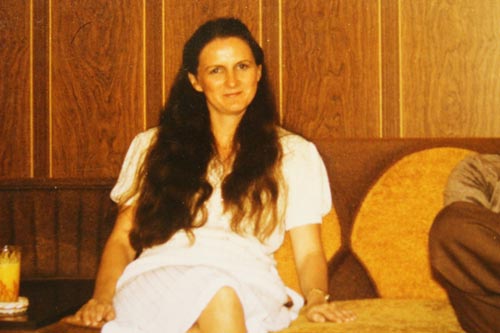
Ruth kicked off her career at UHN in 1970. Pictured above in the 1970s, Ruth has become a key part of the culture at the organization. (Photo: Ruth Gopaul)
Instantly, Ruth fell in love with the tight-knit culture at PMH.
"It didn't matter if you weren't working in a clinical area," she remembers. "You were always made to feel like you and everyone else were there for the patients.
"You were always made to feel that you were part of the team."
In the 1980s, Ruth started working as an assistant to an executive on the management team, then known as "Administration."
It was there that she took a hands-on role in PMH's move to University Ave. and became a witness to the beginnings of the University Health Network.
The big move
In 1987, a new location was chosen for the Princess Margaret Hospital on University Ave., where it stands today.
"They talked about moving for so long, we weren't even sure if it would ever happen," Ruth jokes. As the assistant to Susan Conner, who was the executive in charge of physical planning and redevelopment, Ruth found herself a "frontline worker" in the physical move to University Ave. once the new building was completed.
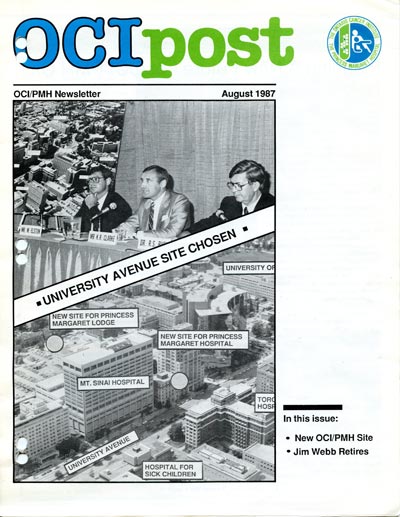
In August 1987, the organization’s newsletter announced the future address of Princess Margaret Hospital (Image courtesy of University Health Network Archives, Toronto.)
"We had to move some of the beds and night stands for a particular unit into the new building just before the move," Ruth remembers. "We would work into the night doing all kinds different jobs once the building was finished."
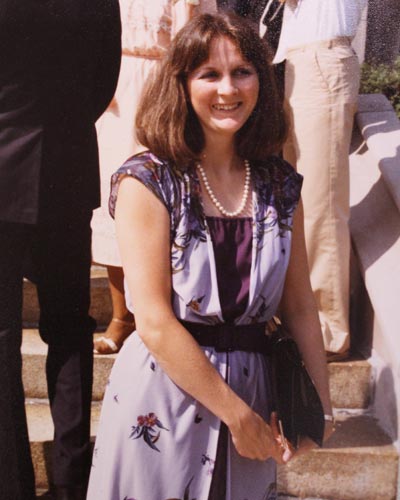
As Susan Conner’s assistant, Ruth had a hands-on role in the hospital’s move to University Ave. (Photo: Ruth Gopaul)
By 1996, the whole hospital – patients, beds, equipment – was in place.
"The building was so beautiful. And it seemed so big," Ruth recalls.
One of the best seats in the house
In 1999, Toronto General and Western Hospitals (then called The Toronto Hospital) and the Princess Margaret became one under the University Health Network umbrella.
That same year, Ruth applied for the Executive Assistant role in the President's office under Dr. Hudson. She landed the position, and stayed to work with UHN's four most recent CEOs: Dr. Hudson, Tom Closson, Dr. Bob Bell, interim CEO Justine Jackson and Dr. Peter Pisters.

Ruth, pictured above in the '90s, landed a job in the President’s Office in 1999, where she would work for the rest of her time at UHN. (Photo: Ruth Gopaul)
During Dr. Bell's time as CEO, he and Ruth would spend at least two months at a time at Toronto Western and Toronto Rehab. The duo would pack up their office at Toronto General and move to TWH and TR on a rotating schedule. Thanks to this road show, Ruth has had the opportunity to work at almost every UHN site.
"Ruth has everyone in Ontario healthcare and government on speed dial and everyone responds immediately when Ruth calls," says Dr. Bell, who is now Ontario's deputy health minister. "The hospital has been extraordinarily fortunate to have Ruth Gopaul as the voice of the CEO."
After only about 14 months with Ruth, Dr. Pisters has also seen her value at UHN.
"Coming in from another country, coming in to a new organization, I couldn't have envisioned a better partner to work with than Ruth," he says.
"I draw the analogy of Peyton Manning retiring – we're watching a star quarterback move off the field."
A work family
It was within these walls that Ruth found a second family. In 2001, Annie Palmer, Receptionist at the RFE Corporate Offices, started her UHN career under Ruth. The two became fast friends.
"We're like Lucy and Ethel – we've got ourselves in some fixes I'll tell you!" Annie jokes in reference to the characters in the 1950s hit TV series
I Love Lucy. "But really - I'd do anything for her, I would. She's taught me so much."
For Ruth, PMH and UHN have always been a second home.
"So much of my life is intertwined with work," she says. "We used to pass around photos of our children, now we pass around photos of our grandchildren. I tell everyone about them."
Indeed, Tom Closson remembers Ruth's stories about her granddaughter fondly.
"Ruth has a granddaughter named Evergreen - a sort of 70s name that I could relate to," he says. "She had lots of pictures of Evergreen on her desk. She talked a lot about how much she enjoyed the weekends that Evergreen stayed with her and would tell me about the funny things that she would do."
Over nearly five decades, Ruth has seen University Health Network grow into the organization it is today. This is a timeline of her time here, and of UHN's growth.
1970 – Ruth starts working as a junior clerk typist at the Princess Margaret Hospital on Sherbourne St.
1973 – Ruth takes a job in Accounts Payable at the old Princess Margaret – writing receipts by hand.
1976 – Switching departments again, Ruth begins working in Payroll – using key-punch machines to generate paycheques for employees.
1980 – Ruth moves to Administration, now known as the executive team, at Princess Margaret Hospital, working as an assistant to an Administrator.
1986 – Toronto General Hospital and Toronto Western Hospital merge. They become, respectively, the Toronto General Division and the Toronto Western Division of The Toronto Hospital (TTH).
1987 – A new site is selected for the Princess Margaret Hospital.
1996 – Princess Margaret Hospital on University Ave. officially opens its doors after a visit from Her Royal Highness The Princess Margaret, Countess of Snowden.
1998 – The Toronto Hospital amalgamates with Princess Margaret Hospital, becoming known as TTH-PMH.
1999 – TTH-PMH changes its name to the University Health Network. Ruth becomes the Executive Assistant to then-President and CEO, Dr. Alan Hudson.
2000 – Tom Closson becomes President and CEO of UHN, with Ruth as his Executive Assistant.
2001 – The new R. Fraser Elliott (RFE) Building officially opens its doors as the Executive Offices. Annie Palmer starts at UHN as the receptionist at RFE, reporting to Ruth.
2005 – Dr. Bob Bell becomes the third President and CEO of UHN Ruth would work for.
2011 – The Toronto Rehabilitation Institute amalgamates with UHN, becoming the organization's fourth hospital and 10th program.
2012 – Princess Margaret Hospital is renamed the Princess Margaret Cancer Centre.
2014 – Dr. Bell leaves UHN. Justine Jackson, now Executive Vice-President Business and Chief Financial Officer, takes over as interim CEO.
2015 – Dr. Peter Pisters becomes President and CEO of UHN, with Ruth as his Executive Assistant.
2016 – The Michener Institute joins the UHN family and becomes the Michener Institute of Education at UHN. Ruth retires in March of 2016.
Now, little Evergreen is 17 years old – the same age that Ruth was when she started her career at UHN.
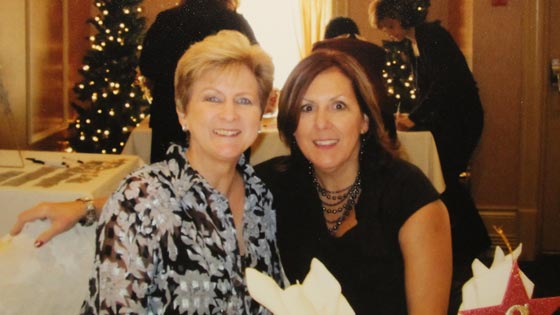
In 2010, Ruth attended Annie’s daughter-in-law’s bridal shower. (Photo: Ruth Gopaul)
Changes
In addition to the personal growth she's experienced over nearly half a century, Ruth has also seen the development of UHN and the field of medicine.
"The medical conditions that people might have died from 40 years ago – they're now walking out of the hospital and healthy," she says. "That has been amazing to witness."
As Annie says, "she'll be truly missed." Because she's worked across all the UHN sites, Ruth has touched many lives. Annie's sure they'll always remember her as "kind, patient, and calm, with a great sense of humour."
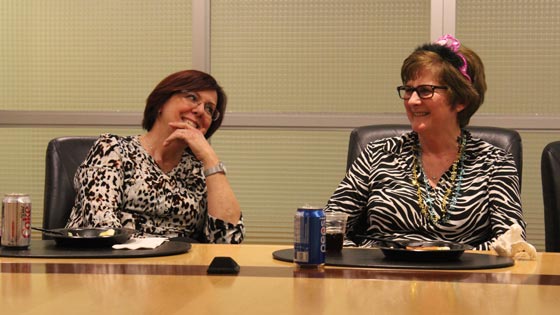
Ruth and Annie shared many laughs at Ruth’s retirement pizza party in the Corporate Offices. (Photo: UHN)
That sentiment isn't lost on Ruth. She's proud of what she's accomplished and the relationships she's made across UHN.
"I will miss the people the most," Ruth says.
"I've been very fortunate for the opportunities I was given. I think these years at UHN have been pretty cool for the young girl that came in off the street and simply asked for a job."
